The mode of action is the overall manner in which a herbicide affects a plant at the tissue or cellular level. Herbicides with the same mode of action will have the same translocation (movement) pattern and produce similar injury symptoms. Understanding target weed types, ideal crop and weed staging, the benefits, and watchouts of each herbicide mode of action can help with deciding which chemical to use and when. Understanding translocation activity can help inform application requirements such as droplet size and water volume. Understanding soil activity and how the herbicide works can help set expectations for when and how long to expect symptoms, when to scout for weed control, and how to identify herbicide symptoms. These are general descriptions and full detail for each herbicide product can be found on the label. Always read and follow label requirements.
Herbicide Resistance Management by Mode of Action
Herbicide resistance is a rising problem of economic significance. Herbicide resistant weed populations continue to develop due to widespread reliance on a small array of common herbicides. When the same herbicide is applied to an area year after year that contains resistant weeds, the susceptible plants die while the resistant ones survive and spread their populations every year. Within a single weed species, there can be resistant and non-resistant (susceptible) populations.
The mode of action classification can be used to understand and manage herbicide resistance. One tool to manage herbicide resistance is to use multiple effective modes of action on the same weed population. This can be done in the same year by tank-mixing or layering multiple modes of action. Additionally, rotating herbicide modes of action from year to year provides another opportunity to manage herbicide resistance. The target weed types for each mode of action provides a quick reference that can be used to help select alternate modes of action with activity on the same weed type. Any opportunity to use another mode of action for weed control lowers the selection pressure that can be caused by repeatedly using the same mode of action on the same weed population. Herbicide resistance is discussed in detail for Group 1 and Group 2 herbicides though resistant weeds have been found for each herbicide mode of action and management practices described above should be used to reduce selection pressure on any herbicide mode of action.
Herbicide Group: 1
Mode of Action: Acetyl-Coenzyme A Carboxylase (ACCase) inhibitors
Target Weed Types: Grasses
Systemic or contact: Systemic
Soil residual: Little to no residual herbicide activity
Crop staging: Post-emergent
Crop staging varies for each herbicide and can be found on the herbicide label.
Weed staging: Post-emergent
Varies somewhat by product but Group 1 herbicides are most effective when applied to young, actively growing weeds.
How it works: Group 1 herbicides inhibit the first step in the formation of long chain fatty acids which are important for cell membrane formation; they ultimately stop new growth. Group 1 herbicides are slow acting as herbicide is translocated through the plant, accumulating in the growing points (roots and shoots). New growth ceases quickly after herbicide application; however, total plant death may take up to three weeks. Early symptoms can be found at the growing point beginning with streaky chlorosis of young leaves (Figure 1). Leaf sheaths decompose within the whorl turning from chlorotic to necrotic and are easily pulled out as the growing point dies (Figure 2). The ACCase enzyme in broadleaf plants is not sensitive to the herbicide and therefore broadleaf plants are not affected by Group 1 herbicides. Some grasses can metabolize the herbicide quicker and can survive while other grasses die. Group 1 herbicides can be used in the registered cereal crops as these crops are able to metabolize the toxin.
Benefits: Group 1 herbicides provide the opportunity to manage some grassy weeds in wheat and barley with no re-cropping concerns.
Watchouts: Antagonism, crop response, herbicide resistance
Antagonism: When applied together or in close succession, some broadleaf herbicides can antagonize Group 1 herbicides. Contact herbicides can quickly burn leaf surfaces, inhibiting absorption of the Group 1 herbicide. The enhanced metabolism caused by Growth Regulator (Group 4) herbicides can allow weeds to also metabolize the Group 1 herbicide before it builds to toxic levels. Group 1 herbicides should only be mixed with registered tank-mix partners.
Crop response: Crop response can be managed by applying Group 1 herbicides within labeled crop stage in good growing conditions with labeled tank-mix partners.
 Figure 1. Leaf streaking caused by Group 1 herbicide.
Figure 1. Leaf streaking caused by Group 1 herbicide.
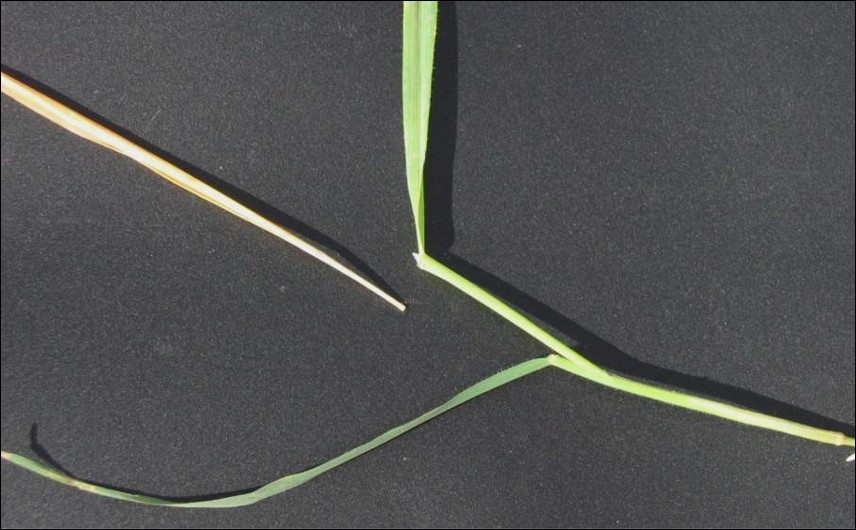 Figure 2. Main shoot death at the growing point. Newest leaf appears yellow or brown and easily pulls out of the leaf sheath.
Figure 2. Main shoot death at the growing point. Newest leaf appears yellow or brown and easily pulls out of the leaf sheath.
Herbicide resistance: Weed populations resistant to Group 1 herbicides will require additional management. There are three herbicide families within Group 1; however, when resistance develops in a weed population typically there is a level of resistance to all Group 1 herbicide families.
Herbicide Group: 2
Mode of Action: Acetolactate synthase (ALS) inhibitors
Target Weed Types: Product specific
Some Group 2 herbicides provide mainly broadleaf weed control. Others provide broadleaf and grassy weed control.
The active ingredients: imazamox, flucarbazone, mesosulfuron, propoxycarbazone, pyroxsulam, and thiencarbazone, provide grassy weed control as well as broadleaf control. The active ingredients: florasulam, thifensulfuron, tribenuron, and metsulfuron provide mainly broadleaf weed control.
Systemic or contact: Systemic
Soil residual: Yes
Residual effects vary for each herbicide; some have season-long residual effects while others have little to no residual effect.
Crop staging: Product specific
Staging varies greatly as some products are applied pre-plant or pre-emerge while other products are foliar applied post-emerge.
Weed staging: Product specific
Some Group 2 herbicides are applied pre-emerge while others are foliar applied.
How it works: Group 2 herbicides inhibit the production of important amino acids. Plants stop growing soon after herbicide uptake and the plant slowly dies. Symptoms may not be noticed with soil applied herbicides because target weeds simply do not emerge, or they may emerge and remain stunted (Figure 3). Plant growth symptoms appear as shortened internodes and stunted roots which may be visible one week after herbicide application. Chlorosis may appear at the growing point (Figure 4). Reddening or purple discolouration is a symptom on both grasses and broadleaves (Figure 5). Broadleaves may also display abnormal growth at the growing point.
 Figure 3. Winter wheat stunting following Group 2 pre-plant application. Photo courtesy of P. Sikkema, University of Guelph
Figure 3. Winter wheat stunting following Group 2 pre-plant application. Photo courtesy of P. Sikkema, University of Guelph
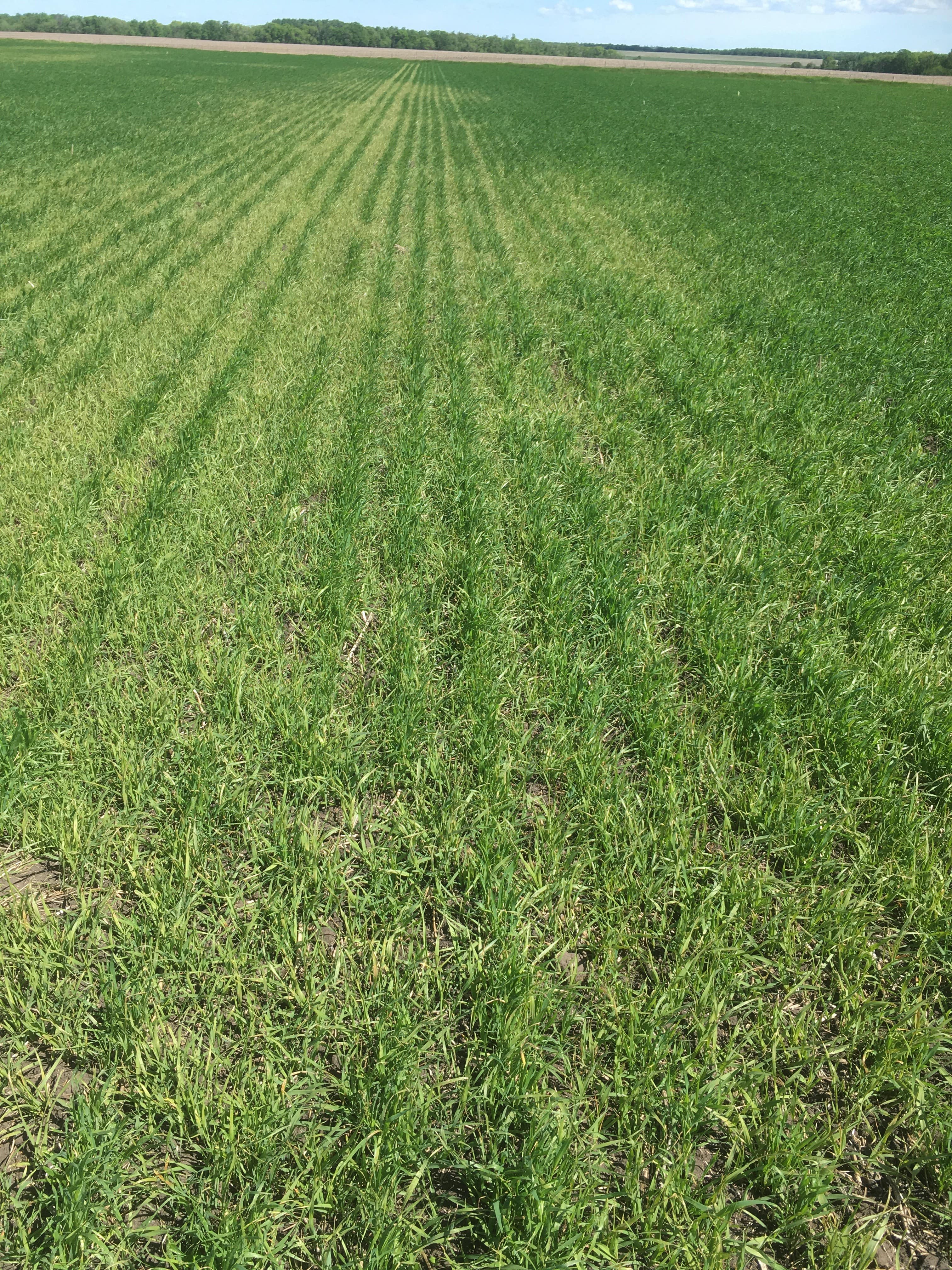 Figure 4. Chlorosis of wild oats between rows of wheat following application of Group 2 herbicide. Photo courtesy of Lyndsey Friesen.
Figure 4. Chlorosis of wild oats between rows of wheat following application of Group 2 herbicide. Photo courtesy of Lyndsey Friesen.
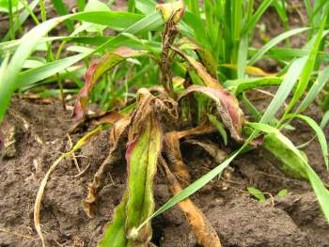 Figure 5. Group 2 herbicide activity causing chlorosis and reddening of leaves and necrosis of the growing point on white campion.
Figure 5. Group 2 herbicide activity causing chlorosis and reddening of leaves and necrosis of the growing point on white campion.
Benefits: Residual weed control of some Group 2 herbicides, grass and broadleaf weed control of some Group 2 herbicides
Watchouts: Herbicide resistance, re-cropping restrictions, crop injury
Herbicide resistance: Cross resistance, or herbicide-resistance to multiple chemical families within a single mode of action, is common with ALS inhibitors.1 Resistance can happen easily with a minimum of a single amino acid substitution at the herbicide target site. Since the target site of the herbicide is not the same as the target site of the enzyme that the herbicide inhibits, there may not be a fitness penalty to the weed, allowing the resistant weed to proliferate.
Re-cropping restrictions: Re-cropping restrictions are another watch-out for some Group 2 herbicides, depending on the specific herbicide chemistry. Soil residual activity of some Group 2 herbicides can be limiting to crop rotation as sensitive crops may not be grown in following years. Residual soil activity is impacted by the herbicide chemistry, the herbicide family, soil pH, soil temperature, soil moisture, soil texture and organic matter in the soil. Some Group 2 herbicides have longer carryover with a high soil pH while others carryover longer when the soil pH is low. In most cases, warm, moist conditions help break down the herbicide and limit carryover concerns as long as the label re-cropping restrictions are followed. High organic matter and high clay content in soil can cause Group 2 herbicides to bind to the soil, becoming unavailable for plant uptake. In this state, the herbicide is unlikely to cause crop injury, but may persist for an extended period and become problematic if a heavy rainfall washes the herbicide back into soil solution. Low organic matter and low clay content can also result in herbicide injury due to carryover following a dry year. In these soils degradation occurs at a lower rate and less herbicide is adsorbed to the soil, leaving herbicides readily available for plant uptake following a rain.1
Crop injury: Crop injury in the year of herbicide application can be managed by applying Group 2 herbicides in good growing conditions where the crop is actively growing and can quickly metabolize the herbicide.
Herbicide Group: 3
Mode of Action: Mitotic Inhibitors, Microtubule Inhibitors, Seedling Growth Inhibitors2
Target Weed Types: Annual grasses with some activity on broadleaf weeds
Systemic or contact: Contact
Soil residual: Yes
Most Group 3 herbicides have full season residual benefits.
Crop staging: Pre-plant incorporated
Weed staging: Pre-emerge
Group 3 herbicides are not effective on established weeds.
How it works: Group 3 herbicides are absorbed primarily by roots of emerging seedlings and can also be absorbed by emerging shoots. The herbicide works as a contact herbicide at the point of uptake (roots and shoots) to stop cell division and inhibit new growth. The seedling must germinate before herbicide can be effective. Often, controlled seedlings do not emerge from the soil surface. As seedlings emerge root growth is reduced, and stems may be swollen or brittle (Figure 6).
Benefits: Season-long residual control of target weeds
Watchouts: Application, carryover
Application: These herbicides have specific instructions for application and require incorporation (harrowing at minimum) to prevent break-down by light and loss by volatilization.
Carryover: Application rates must be followed to prevent crop injury or carry-over. Rates are limited by soil organic matter and soil texture.
 Figure 6. Short, stubby roots are a symptom of Group 3 herbicide activity. Photo courtesy of Rebekah D. Wallace, University of Georgia, Bugwood.org
Figure 6. Short, stubby roots are a symptom of Group 3 herbicide activity. Photo courtesy of Rebekah D. Wallace, University of Georgia, Bugwood.org
Herbicide Group: 4
Mode of Action: Synthetic auxins
Target Weed Types: Annual, winter annual, and biennial broadleaves with some suppression or control of perennial broadleaves and limited activity on grasses
Systemic or contact: Systemic
Soil residual: Some
Length of residual varies by product and rate.
Crop staging: Pre- or post-emerge
Weed staging: Wide range of weed staging depending on weed species and herbicide product
In-crop applications should target young, actively growing annuals. Perennials are best controlled with Group 4 herbicides when applied in the fall at bud stage.
How it works: Group 4 herbicides are taken up by leaves, stems, and roots and translocated to the growing points in roots and shoots where they stimulate uncontrolled cell division and growth. Symptoms on new growth are twisting and curving of petioles and stems and distorted leaves and heads (Figure 7). Plant death is slow.
Benefits: Effective broadleaf weed management in cereal crops.
Watchouts: Re-cropping restrictions, herbicide resistance
Re-cropping restrictions: This can be a concern for some Group 4 herbicides, such as clopyralid, especially in application years with lower-than-average rainfall.
Herbicide resistance: As herbicides are widely used, there are some weeds with Group 4 herbicide resistance.
 Figure 7. Cleavers showing leaf cupping and twisting stems following application of Group 4 herbicide. Photo courtesy of Eric Johnson, University of Saskatchewan.
Figure 7. Cleavers showing leaf cupping and twisting stems following application of Group 4 herbicide. Photo courtesy of Eric Johnson, University of Saskatchewan.
Herbicide Group: 6
Mode of Action: Fast-acting photosynthesis inhibitors
Target Weed Types: Annual broadleaves
Systemic or contact: Contact
Soil residual: Little to no residual herbicide activity
Crop staging: Post emerge
Can be applied pre-emerge to crop but can only control weeds that have emerged. See herbicide label for specific crop staging.
Weed staging: Small, young weeds
Herbicide must contact foliage of weeds. See herbicide label for specific weed staging.
How it works: Group 6 herbicides are contact herbicides that are primarily absorbed by plant foliage. They act quickly, inhibiting photosynthesis, resulting in water-soaked lesions that quickly become chlorotic and die within days of application. These herbicides work best when they have contact with the growing point. Following herbicide application, perennial broadleaves can appear burnt off and dead and later regrow from root reserves.
Benefits: Fast-acting annual broadleaf weed control
Watchouts: Coverage, crop injury
Coverage: Thorough coverage is essential for weed control with Group 6 herbicides. Droplet size, water volume, weed size, and crop canopy density can all impact weed control. Smaller droplets can provide more thorough coverage but can also be more prone to particle drift. Follow the label recommendations for appropriate droplet size for the herbicide. Increased water volume on small seedling weeds prior to crop canopy closure are some management practices that can be used to encourage thorough coverage with Group 6 herbicides.
Crop injury: Increased herbicide uptake can result in crop injury. This can be a result of a thin cuticle such as when the crop is young, or when environmental conditions change quickly from cool and wet to hot and humid. Application within two to three days of stressful growing conditions may also result in crop injury (Figure 8).
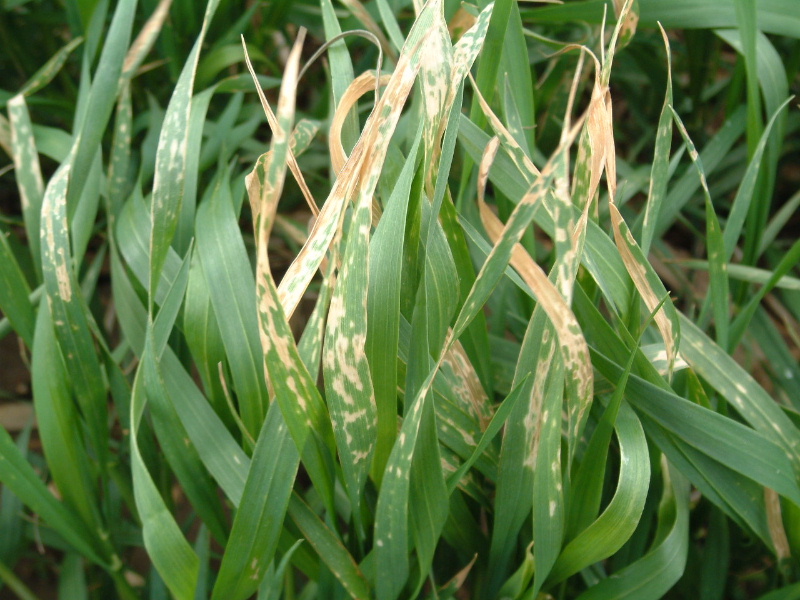 Figure 8. Group 6 herbicide applied with adverse weather conditions (same-day freezing). Photo courtesy of P. Sikkema, University of Guelph.
Figure 8. Group 6 herbicide applied with adverse weather conditions (same-day freezing). Photo courtesy of P. Sikkema, University of Guelph.
Herbicide Group: 9
Mode of Action: Enolpyruvyl Shikimate Phosphate Synthase (EPSPS) Inhibitors
Target Weed Types: Annual, biennial, and perennial grass, sedge, and broadleaf weeds
Systemic or contact: Systemic
Soil residual: No
Crop staging: Pre-emerge, preharvest, or postharvest
Weed staging: Post-emerge
Ideal timing varies by weed. Annual and winter annual weeds can be managed prior to crop emergence. A pre-harvest application is better suited for management of perennial weeds such as Canada thistle, perennial sow thistle, quackgrass, and milkweed. Postharvest applications can also be utilized for weed management.
How it works: Glyphosate, the only Group 9 herbicide, is rapidly absorbed by foliage of target weeds. It is translocated and accumulated in growing points, underground tissues, and immature leaves. Glyphosate inhibits the synthesis of key amino acids needed for protein synthesis. Growth stops soon after herbicide application though additional symptoms may be slower to appear, especially in perennial weeds. Chlorosis of the growing point and new leaves is followed by plant death which may take up to three weeks (Figures 9 and 10).
Benefits: Glyphosate is a broad-spectrum herbicide effective on many weeds.
Watchouts: Application timing, herbicide resistance
Application timing: Glyphosate will kill emerged cereal crops. Apply pre-emerge to the cereal crop. In preharvest applications, crop staging is important as early applications may result in unacceptable herbicide residue in harvested grain.
Herbicide resistance: As herbicides are widely used, there are some weeds with Group 9 herbicide resistance.
 Figure 9. Early symptoms of chlorosis and necrosis following glyphosate application.
Figure 9. Early symptoms of chlorosis and necrosis following glyphosate application.
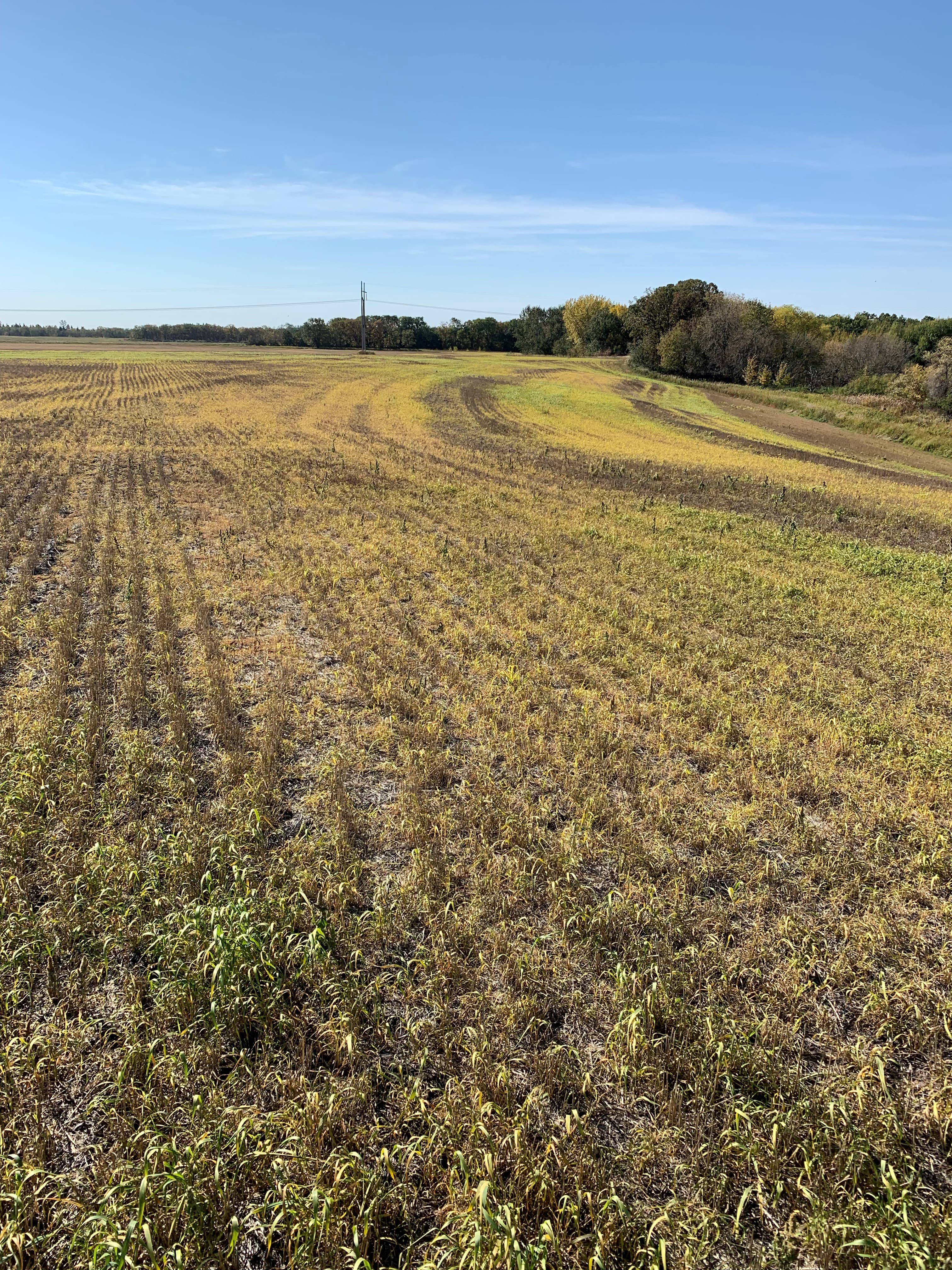 Figure 10. Symptoms of glyphosate application on grassy weeds. Field begins to appear dull green to yellow as chlorosis begins in weeds.
Figure 10. Symptoms of glyphosate application on grassy weeds. Field begins to appear dull green to yellow as chlorosis begins in weeds.
Herbicide Group: 14
Mode of Action: Protoporphyrinogen IX oxidase (PPO) inhibitors
Target Weed Types: Primarily broadleaves
Some Group 14 herbicides provide suppression of some annual grasses.
Systemic or contact: Contact
Soil residual: Product specific
Residual can be minimal or last for several weeks.
Crop staging: Preplant, pre-emerge, preharvest
Weed staging: Product specific
Foliar applied herbicides should be applied to small, actively growing weeds. Soil applied herbicides are taken up by weeds prior to emergence.
How it works: Group 14 herbicides are readily absorbed by foliage of emerged plants or by roots of emerging plants. Singlet oxygen radicals are formed due to PPO inhibition. These oxygen radicals destroy cell membranes resulting in loss of chlorophyll, necrosis, and plant death. The first symptoms of herbicide activity are water-soaked lesions followed by bronzing and then necrosis (Figure 11). Symptoms can appear within hours of herbicide application with plant death occurring quickly only a few days later.
Light is required to activate these herbicides. Seedlings may take up the herbicide and then emerge from soil surface before herbicide activity occurs. Banding at the soil line is a good sign that this herbicide activity has occurred and weed seedlings die shortly after emergence.
Benefits: Fast-acting annual broadleaf weed control. Soil residual activity of some Group 14 herbicides provides longer weed control.
Watchouts: Coverage, soil activation, re-cropping restrictions, application timing
Coverage: The foliar applied herbicides require thorough coverage when applied to emerged weeds.
Soil activation: Soil applied herbicides require rainfall for activation.
Re-cropping restrictions: Soil applied herbicides may limit rotational crop options.
Application timing: Group 14 herbicides are preplant, pre-emerge, and preharvest herbicides for cereal crops. In-crop application can cause serious crop injury (Figure 12). Read and follow the label to ensure crop safety.
 Figure 11. Watersoaked lesions on redroot pigweed are early symptoms of Group 14 herbicide activity. Photo courtesy of Eric Johnson, University of Saskatchewan.
Figure 11. Watersoaked lesions on redroot pigweed are early symptoms of Group 14 herbicide activity. Photo courtesy of Eric Johnson, University of Saskatchewan.
 Figure 12. Group 14 injury from post-emergent application in small plots of cereal crops (front). Photo courtesy of P. Sikkema, University of Guelph.
Figure 12. Group 14 injury from post-emergent application in small plots of cereal crops (front). Photo courtesy of P. Sikkema, University of Guelph.
Herbicide Group: 15 (now includes Group 8)
Mode of Action: Very long-chain fatty acid synthesis inhibitors
Target Weed Types: Annual grasses, some small-seeded broadleaves
Target weeds are very specific to the herbicide. Triallate only controls wild oats.
Systemic or contact: Systemic*
*Herbicide can translocate but this in not relevant since the herbicide works at the point of uptake on seedling weeds.
Soil residual: Yes
Crop staging: Preplant, preplant incorporated, pre-emerge
Weed staging: Pre-emerge
How it works:
Group 15 herbicides are absorbed primarily by shoots of emerging seedlings; root uptake is also possible. Very long chain fatty acid inhibition results in disruption of cell membrane formation and cell growth. Seedling plants affected by Group 15 herbicides often fail to emerge or emerge severely deformed or with inhibited root growth (Figure 13). In grassy weeds, the new leaf may appear malformed or fail to unroll (Figure 14). In broadleaf weeds, necrosis may appear on leaf margins and the “drawstring” effect may appear on new leaves (Figure 15).
Benefits: Residual control
Watchouts: Rainfall activation, incorporation, soil properties, application timing
Rainfall activation: These herbicides require rainfall within 10 to 14 days of application for successful activation.
Incorporation: Incorporation requirements vary for Group 15 herbicides.
Soil properties: Risk of crop injury increases when these herbicides are applied on coarse textured soils with low organic matter. Specific information for each herbicide can be found on the herbicide’s label. Residual activity can be reduced over time or with low rates, excessive rainfall, or warm and moist conditions that encourage microbial breakdown of the herbicide.
Application timing: These are preplant and pre-emerge herbicides and are not for use in-crop.
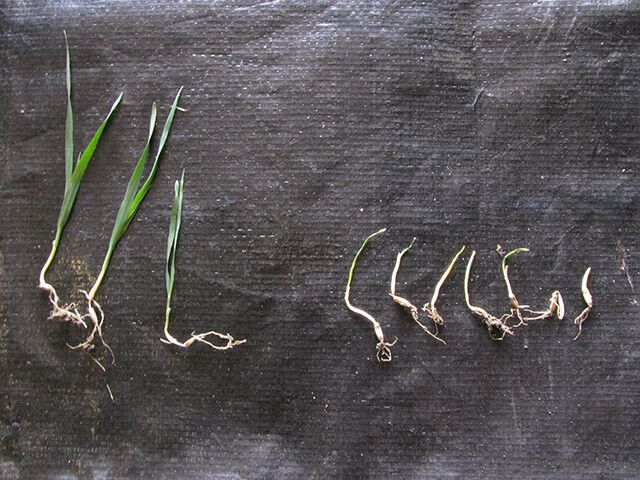 Figure 13. Untreated on left compared to triallate treated wild oats on right. Photo courtesy of Eric Johnson, University of Saskatchewan.
Figure 13. Untreated on left compared to triallate treated wild oats on right. Photo courtesy of Eric Johnson, University of Saskatchewan.
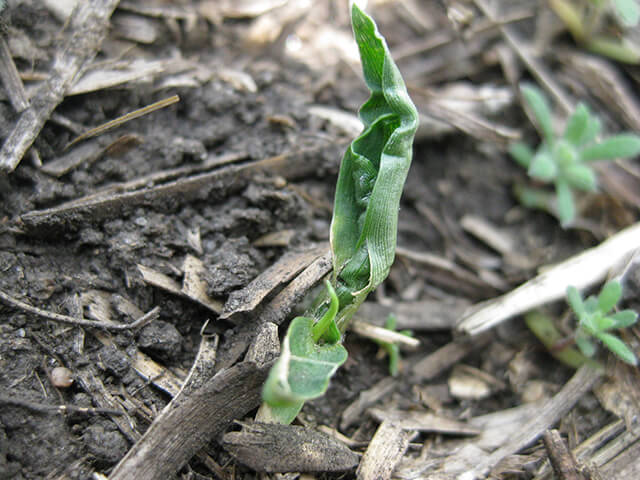 Figure 14. Malformed leaves of green foxtail as a result of Group 15 herbicide. Photo courtesy of Eric Johnson, University of Saskatchewan.
Figure 14. Malformed leaves of green foxtail as a result of Group 15 herbicide. Photo courtesy of Eric Johnson, University of Saskatchewan.
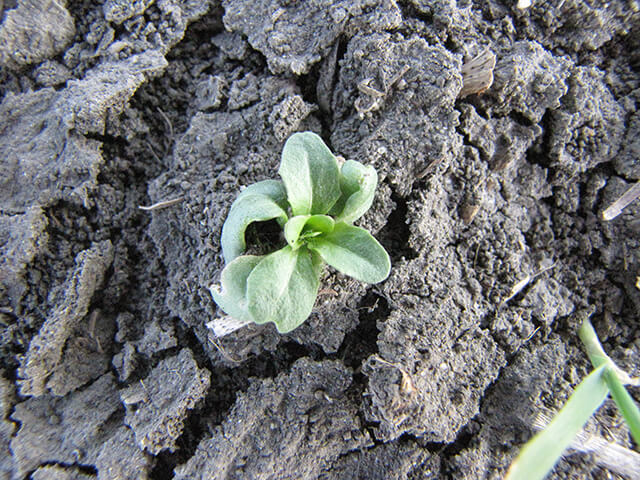 Figure 15. Drawstring effect on stinkweed leaf. Photo courtesy of Eric Johnson, University of Saskatchewan.
Figure 15. Drawstring effect on stinkweed leaf. Photo courtesy of Eric Johnson, University of Saskatchewan.
Herbicide Group: 27
Mode of Action: Hydroxyphenyl pyruvate dioxygenase (HPPD) inhibitors
Target Weed Types: Annual broadleaves
Some Group 27 herbicides also have activity on grasses or perennial broadleaf weeds.
Systemic or contact: Systemic
Soil residual: Product specific
Currently registered Group 27 herbicides for cereal crops are applied post-emerge with little soil residual benefit.
Crop staging: Product specific
For cereal crops, the Group 27 herbicides currently available are post-emerge herbicides. The crop should be between the 1-leaf stage and flag leaf visible but still rolled.
Weed staging: Product specific
For cereal crops, the Group 27 herbicides currently available are applied in-crop to emerged weeds. Weeds should be young and actively growing.
How it works: Group 27 herbicides are translocated to roots and shoots and symptoms first appear at these growing points. The inhibition of HPPD stops production of carotenoids. The result is severe bleaching of foliage which appears two to three days after herbicide application (Figures 16, 17, and 18). Plant growth is inhibited followed by plant death.
Benefits: Synergy with Group 5 and 6 herbicides on broadleaf weed control, additional mode of action for broadleaf weed control
Watchouts: Residual activity
Residual activity: Following seasons of low rainfall, microbial breakdown of herbicide is limited, and Group 27 herbicides can persist to the following growing season.
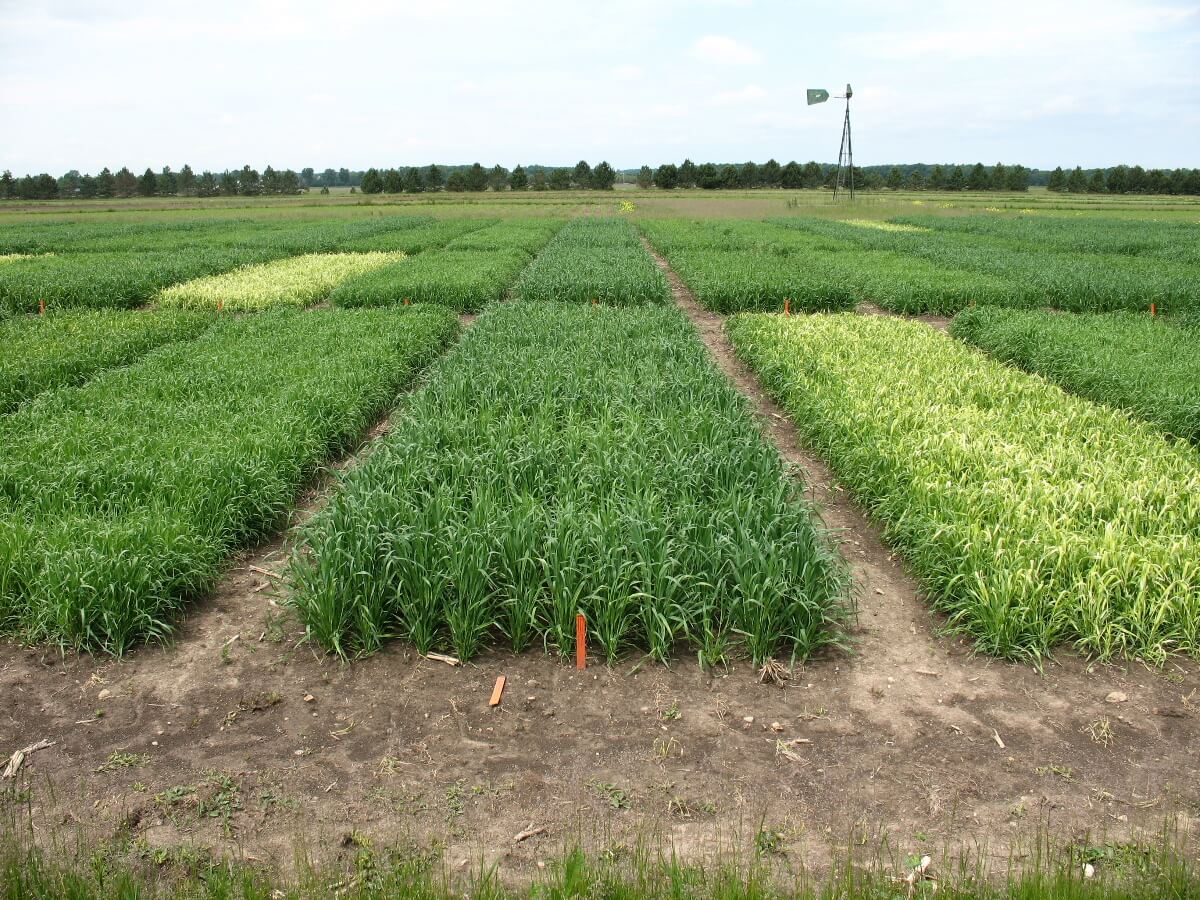 Figure 16. Typical bleaching of Group 27 herbicide is very visual in small plots. Photo courtesy of P. Sikkema, University of Guelph.
Figure 16. Typical bleaching of Group 27 herbicide is very visual in small plots. Photo courtesy of P. Sikkema, University of Guelph.
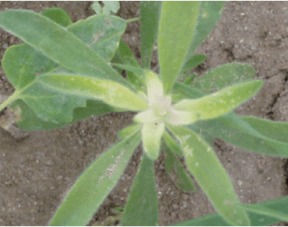 Figure 17. Bleaching of growing point of kochia caused by Group 27 herbicide.
Figure 17. Bleaching of growing point of kochia caused by Group 27 herbicide.
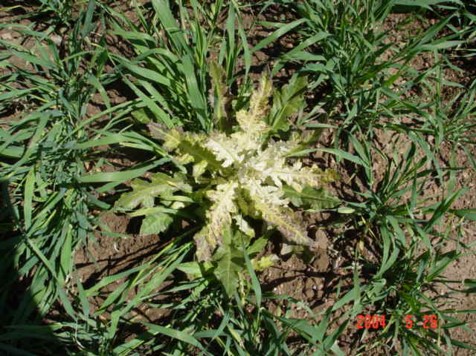 Figure 18. Bleaching of growing point of Canada thistle caused by Group 27 herbicide.
Figure 18. Bleaching of growing point of Canada thistle caused by Group 27 herbicide.
Sources:
1 The Canola Council of Canada. 2019. Dry conditions elevate herbicide carryover risk. Canola Watch February 8, 2019 Issue 2. https://www.canolacouncil.org/canola-watch/2019/02/08/dry-conditions-elevate-herbicide-carryover-risk/
2 Powles, S.B., Yu, Q. 2010. Evolution in action: Plants resistant to herbicides. Annual Review of Plant Biology Vol. 61: 317-347. DOI 10.1146
Sikkema, P., Robinson D., Johnson, E. 2021. Weed science short course. University of Guelph.
Ontario Ministry of Agriculture, Food and Rural Affairs. 2009. Herbicide mode of action categories. Factsheet ISSN 11980712X. http://www.omafra.gov.on.ca/english/crops/facts/00-061.htm
Manitoba Agriculture and Resource Development. 2020. Guide to crop protection 2020.
Herbicide Resistance Action Committee. 2021. HRAC Mode of Action Classification 2021. www.hracglobal.com
Legal Statements
Performance may vary from location to location and from year to year, as local growing, soil and weather conditions may vary. Growers should evaluate data from multiple locations and years whenever possible and should consider the impacts of these conditions on the grower’s fields.
Tank mixtures: The applicable labeling for each product must be in the possession of the user at the time of application. Follow applicable use instructions, including application rates, precautions and restrictions of each product used in the tank mixture. Bayer has not tested all tank mix product formulations for compatibility or performance other than specifically listed by brand name. Always predetermine the compatibility of tank mixtures by mixing small proportional quantities in advance. Bayer and Bayer Cross are registered trademarks of Bayer Group. Used under license. ©2021 Bayer Group. All rights reserved. 1037_S1_CA